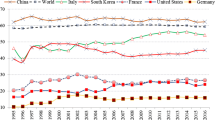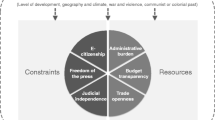Abstract
Rankings of countries by perceived corruption have emerged over the past decade as leading indicators of governance and development. Designed to highlight countries that are known to be corrupt, their objective is to encourage transparency and good governance. High rankings on corruption, it is argued, will serve as a strong incentive for reform. The practice of ranking and labeling countries “corrupt,” however, may have a perverse effect. Consistent with Social Labeling Theory, we argue that perceptual indices can encourage the loss of needed investment and, thus, contribute to higher rates of corruption within unfavorably ranked countries. In effect, corruption indices may inhibit foreign direct investment, the effect of which is to encourage the status quo in terms of corruption ranking. Using an experimental study design, we test the effects of country corruption rankings on the assessment of country investment desirability and find ranking exposure causes shifts in country investment desirability for 10 of 12 countries studied. These findings suggest that corruption rankings, which are based on perceptions of corruption, may cause country isolation and a reduction in legitimate means of investment.
Similar content being viewed by others
References
Alesina, A. and B. Weder: 2002, `Do Corrupt Governments Receive Less Foreign Aid?', The American Economic Review 92, 1126–1137.
Becker, H. S. 1963. Outsiders: Studies in the sociology of deviance. New York: The Free Press.
Dunfee, T.W. & Hess, D. 2001. Getting from Salbu to the ‘Tipping Point’: The role of corporate action Within a portfolio of anti-corruption strategies. Northwestern Journal of International Law & Business, 21(2) 471-490.
Galtung, F. 2005 “Measuring the Immeasurable: Boundaries and Functions of (Macro) Corruption Indices,” in F. Galtung & C. Sampford (eds.), Measuring Corruption. London: Ashgate.
Goffman, E. 1963. Stigma: Notes on the management of spoiled identity. Englewood Cliffs, NJ: Prentice-Hall.
Goldsmith, A. A. 1999. Slapping the grasping hand: Correlates of political corruption in emerging markets. American Journal of Economics & Sociology, 58:865-883.
Habib, M. & Zurawicki, L. 2002. Corruption and Foreign Direct Investment, Journal of International Business Studies 33: 291-307.
Hess, D. and Dunfee, T.W.: 2000, ‘Fighting Corruption: A Principled Approach’, Cornell International Law Journal, 33 (3), 593-626.
Husted, B. W. 1999. Wealth, Culture, and Corruption. Journal of International Business Studies, 30: 339-359.
Johnston, M. 2004. Comparing corruption: Participation, institutions, and development. In Heffernan, W. C. & Kleinig, J. (Eds). Private and Public Corruption. Lanham, Maryland: Rowman & Littlefield Publishers, Inc., pp. 275-322.
Lambsdorff, J. G. 2003. How corruption affects persistent capital flows, Economics of Governance, 4: 229-243.
Laufer, W. S. 2006. The importance of cynicism and humility: Anti-corruption partnerships with the private sector. Development Outreach, 8: 18-21.
Maragay, F. V.: 2006, `Corruption Survey Lacks Transparency', Manila Standard, November 10, 2006.
Nelken, D. & Levi, M. 1996. The corruption of politics and the politics of corruption: An overview. Journal of Law and Society, 23: 1-17.
O’Higgins, E. R. E. 2006. Corruption, underdevelopment, and extractive resource industries: Addressing the vicious cycle. Business Ethics Quarterly, 16: 235-254.
PR Newswire: 2008, `Dow Jones Announces Partnership with Transparency International’, October 23, 2008. 8:00 AM GMT.
Rodriquez, P., Uhlenbruck, K., Eden, L. 2005. Government Corruption and the Entry Strategies of Multinationals, Academy of Management Review , 30: 383-396.
Steensma, H.K., Tihanyi, L., Lyles, M. A. & Dhanaraj, C. 2005. The evolving value of foreign partnerships in transitioning economies, Academy of Management Journal, 48: 213-235.
The Economist: 2008, `Asia: The graft-busters strike against Indonesia’s anti-corruption drive', September 27, 2008.
Transparency International. 2006. Corruption perceptions index. Berlin: Transparency International.
Warren, D.E. 2003. “Constructive and destructive deviance in organizations.” Academy of Management Review, 28: 622-632.
Warren, D. E. 2007. “Corporate scandals and spoiled identities: How organizations shift stigma to employees.” Business Ethics Quarterly, 17: 477-496.
Wilhelm, P.G. 2002. International validation of the corruption perception index: Implications for business ethics and entrepreneurship education. Journal of Business Ethics, 35:177-189.
Acknowledgments
We would like to thank Gem Guiang for her excellent research assistance and the Zicklin Center for Business Ethics Center for funding this project.
Tom Dunfee affected our development as academics. This article reflects Tom’s influence on our scholarship in two ways. It advances the discussion of corruption, a topic that was an ongoing concern of Tom’s. It also reflects Tom’s approach to scholarship – to thoughtfully question even those concepts that are widely accepted and respected. Here we question the legitimacy and influence of popular corruption rankings because of their empirical shortcomings and potential damage to developing economies. We will sorely miss hearing Tom’s critique of our work and seeing a warm grin spread across his face as we exchange ideas. More than anything, we will miss Tom’s mentorship, leadership and unwavering integrity.
Author information
Authors and Affiliations
Corresponding author
Rights and permissions
About this article
Cite this article
Warren, D.E., Laufer, W.S. Are Corruption Indices a Self-Fulfilling Prophecy? A Social Labeling Perspective of Corruption. J Bus Ethics 88 (Suppl 4), 841–849 (2009). https://doi.org/10.1007/s10551-009-0316-5
Published:
Issue Date:
DOI: https://doi.org/10.1007/s10551-009-0316-5




